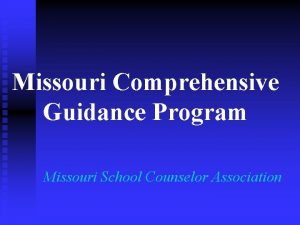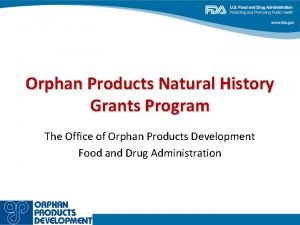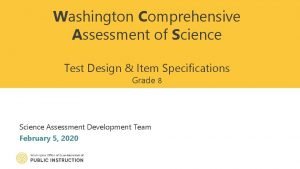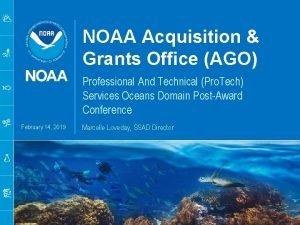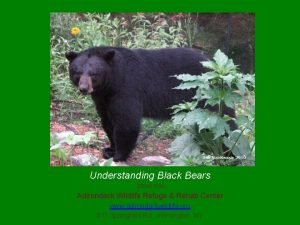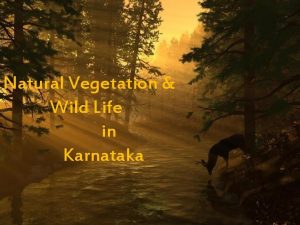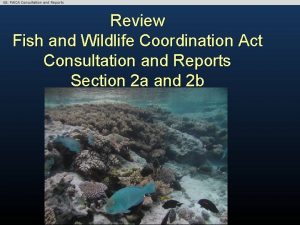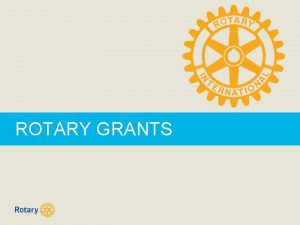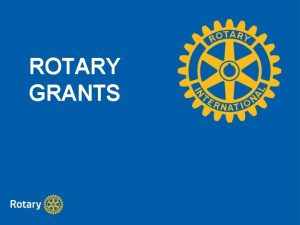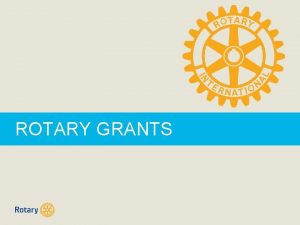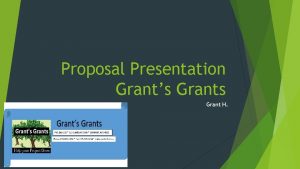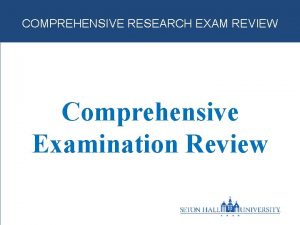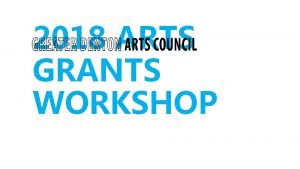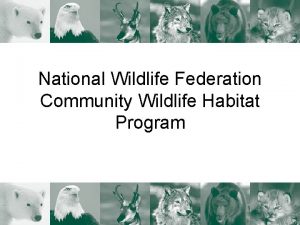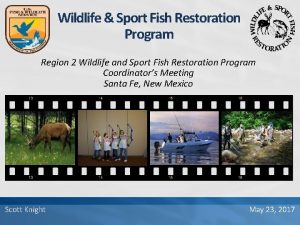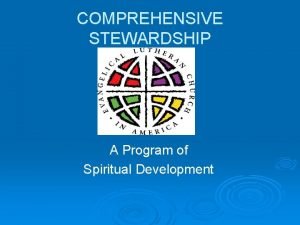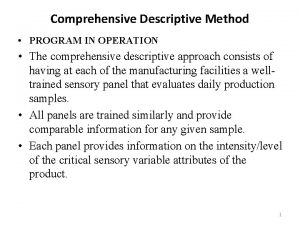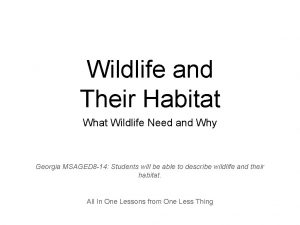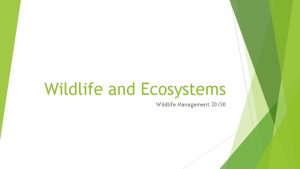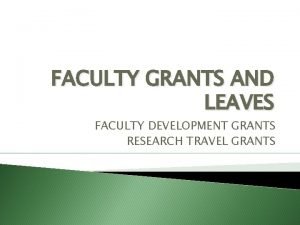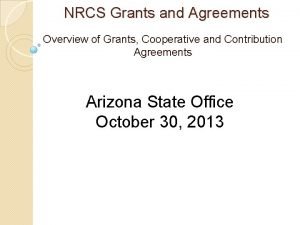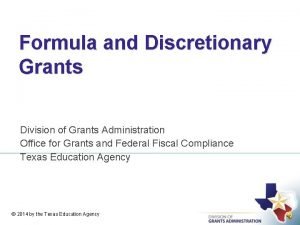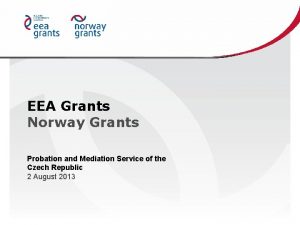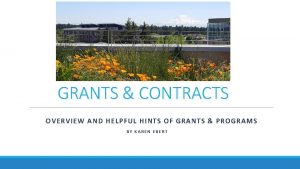State Wildlife Grants Program and the Comprehensive Wildlife




































- Slides: 36

State Wildlife Grants Program and the Comprehensive Wildlife Conservation Strategy Jenny A. Landry NYS Department of Environmental Conservation

Conserving Biodiversity § US laws and policies place primary responsibility for wildlife management in the hands of the states § State Wildlife Grants provides Federal dollars to support cost effective conservation aimed at preventing wildlife from becoming endangered. NYS Department of Environmental Conservation

Background of the State Wildlife Grants Program § The program was first authorized by congress in 2002 § Program grew out of Conservation and Reinvestment Act compromise language § Program is subject to annual congressional legislation NYS Department of Environmental Conservation

What does the program do? § SWG program is intended to assist states in biodiversity preservation – Tied to “species in greatest need of conservation” – These are species which have not traditionally received funding for management – Intended to avoid new listings of endangered species NYS Department of Environmental Conservation

How does the program work? § Congress makes an annual appropriation § The funds are apportioned to each state based on a formula § States had to commit to write a Comprehensive Wildlife Conservation Strategy by Oct. 2005 – Targeted toward “species of greatest conservation need” NYS Department of Environmental Conservation

How does the program work? (cont’d) § The individual states apply for their apportionment annually from USFWS § The program pays for both species investigations and implementation projects § Match required - 50% NYS Department of Environmental Conservation

Comprehensive Wildlife Conservation Strategy § Mandated by congress to remain eligible for funding § Submitted to USFWS for acceptance NYS Department of Environmental Conservation

Comprehensive Wildlife Conservation Strategy Structure § Organized by major watersheds of the state § Species information analyzed by each watershed – List species occurring in the basin – List critical habitats of the basin – Priority conservation actions in the basin § Information from other planning documents reviewed and included. NYS Department of Environmental Conservation

N NYS Department of Environmental Conservation

Fish Highlights § § § § Sturgeon American eel Longear sunfish Brook trout Anadromous species Winter flounder Gilt darter NYS Department of Environmental Conservation

Bird Highlights § § § Raptors Shorebirds Marsh birds Common nighthawk Waterfowl Colonial nesters NYS Department of Environmental Conservation

Mammal highlights: § § § Bats Lynx Cougar Wolf American marten River otter NYS Department of Environmental Conservation

Amphibian and Reptile Highlights: § § § Snakes Salamanders Frogs and toads Turtles Hellbender NYS Department of Environmental Conservation

Invertebrate Highlights: § Moths § Dragonflies and damselflies § Mussels § Chittenango ovate amber snail NYS Department of Environmental Conservation

Top Threats to Species of Greatest Conservation Need Statewide § Habitat loss and fragmentation – Only 15% of state land area in public ownership § Contaminant deposition – Acids – Mercury – Nitrogen products § Degraded water quality & altered hydrology NYS Department of Environmental Conservation

§ § § Top Threats to Species of Greatest Conservation Need Statewide (cont’d) Invasive species Changing farm and forestry practices Direct human-wildlife interactions – Collisions – Poaching – Unregulated harvest § Climate change NYS Department of Environmental Conservation

Outcomes – Conservation Recommendations § § § § Data Collection Planning Management and Restoration Land Protection Regulatory and Legislative Information Dissemination Incentives and Disincentives NYS Department of Environmental Conservation

Outcomes – Policy and Practice § Moving away from single species management. § Integrating fish and wildlife management with environmental quality. § Dealing with species metapopulations § Integrating fish and wildlife disciplines through habitat management. NYS Department of Environmental Conservation

New Ways of Working Under SWG § Addressing both natural resources and environmental quality issues § Creating stronger interdivisional relationships – Division of Fish, Wildlife and Marine Resources – Division of Lands and Forests – Division of Water NYS Department of Environmental Conservation

NY’s SWG funding so far… Federal Fiscal Year FFY 2001 National Total $50 M NY Allocation $2. 33 M FFY 2002 FFY 2003 $85 M $65 M $3. 73 M $2. 78 M FFY 2004 $70 M $2. 95 M FFY 2005 $69. 12 M $2. 94 M FFY 2006 $68. 5 M $2. 90 M NYS Department of Environmental Conservation

New Staff § Federal Fiscal Year 2004 funds were used to hire 9 ecologists within 11 major watersheds and 1 data coordinator § This single year of funds will cover staff salaries for at least three years § New staff will implement the SWG program and the recommendations in the CWCS NYS Department of Environmental Conservation

New Biologists’ Duties § Develop and write 5 -year action plans in consultation with Watershed Team and Agency Staff § Recruit Watershed Team members § Annual watershed priority development for RFA § Watershed project oversight/management § Watershed project implementation § Annual grant reporting § Communicate CWCS issues with Watershed Team, other DEC Divisions and programs in the regions NYS Department of Environmental Conservation

New Staff Jason Smith Lower Hudson – LI Bays & Region 2 Office, Long Atlantic Ocean Island City Gregg Kenney Delaware & Upper Hudson Region 3 – New Paltz Paul Novak Upper Hudson Region 4 – Schenectady Joe Racette Lake Champlain Region 5 – Raybrook Angelena Ross NE Lake Ontario Region 6 – Watertown Tom Bell Susquehanna Region 7 – Cortland Amy Mahar SE Lake Ontario Region 8 – Avon Jenny Landry SW Lake Ontario Region 8 – Avon VACANT Lake Erie & Allegheny Region 9 – Allegany Carl Herzog Data Management Central Office - Albany NYS Department of Environmental Conservation

NY Forests Forest cover has returned to 60% of the land area of New York concurrent with the decline of agriculture. Need active management of vegetative succession Sustainable forest practices, in accordance with BMPs, improve forest health and resilience NYS Department of Environmental Conservation

72% of forest land in New York is privately owned. NYS Department of Environmental Conservation

NYFOA Contract § Develop Materials and Website § Publicize CWCS implementation needs to Forest Owners § Landowner visits § Database § Map of landowners and critical habitats § Strategic Plan NYS Department of Environmental Conservation

Boreal Forest Birds NYS Department of Environmental Conservation

Deciduous/Mixed Forest Breeding Birds NYS Department of Environmental Conservation

Early Successional Forest/Shrubland Birds NYS Department of Environmental Conservation

Forest Breeding Raptors NYS Department of Environmental Conservation

High Altitude Conifer Forest Birds NYS Department of Environmental Conservation

Tree Bats NYS Department of Environmental Conservation

Vernal Pool Salamanders NYS Department of Environmental Conservation

Woodland/Grassland Snakes NYS Department of Environmental Conservation

Thank you! Jenny Ann Landry NYSDEC jalandry@gw. dec. state. ny. us 585 -226 -5491 NYS Department of Environmental Conservation

NYS Department of Environmental Conservation
 Missouri school counseling lesson plans
Missouri school counseling lesson plans Missouri school counselor association
Missouri school counselor association Museum timelinefy
Museum timelinefy Responsive
Responsive Wa.portal.cambiumast
Wa.portal.cambiumast Noaa nesdis org chart
Noaa nesdis org chart Lcif grants and donations
Lcif grants and donations How did land grants and new roads affect brazil?
How did land grants and new roads affect brazil? Adk wildlife refuge
Adk wildlife refuge Types of vegetation of karnataka
Types of vegetation of karnataka Fish and wildlife coordination act
Fish and wildlife coordination act Anwr drilling pros and cons
Anwr drilling pros and cons Hát kết hợp bộ gõ cơ thể
Hát kết hợp bộ gõ cơ thể Lp html
Lp html Bổ thể
Bổ thể Tỉ lệ cơ thể trẻ em
Tỉ lệ cơ thể trẻ em Chó sói
Chó sói Glasgow thang điểm
Glasgow thang điểm Alleluia hat len nguoi oi
Alleluia hat len nguoi oi Môn thể thao bắt đầu bằng chữ đua
Môn thể thao bắt đầu bằng chữ đua Thế nào là hệ số cao nhất
Thế nào là hệ số cao nhất Các châu lục và đại dương trên thế giới
Các châu lục và đại dương trên thế giới Công thức tính độ biến thiên đông lượng
Công thức tính độ biến thiên đông lượng Trời xanh đây là của chúng ta thể thơ
Trời xanh đây là của chúng ta thể thơ Mật thư tọa độ 5x5
Mật thư tọa độ 5x5 Làm thế nào để 102-1=99
Làm thế nào để 102-1=99 độ dài liên kết
độ dài liên kết Các châu lục và đại dương trên thế giới
Các châu lục và đại dương trên thế giới Thơ thất ngôn tứ tuyệt đường luật
Thơ thất ngôn tứ tuyệt đường luật Quá trình desamine hóa có thể tạo ra
Quá trình desamine hóa có thể tạo ra Một số thể thơ truyền thống
Một số thể thơ truyền thống Bàn tay mà dây bẩn
Bàn tay mà dây bẩn Vẽ hình chiếu vuông góc của vật thể sau
Vẽ hình chiếu vuông góc của vật thể sau Biện pháp chống mỏi cơ
Biện pháp chống mỏi cơ đặc điểm cơ thể của người tối cổ
đặc điểm cơ thể của người tối cổ Ví dụ về giọng cùng tên
Ví dụ về giọng cùng tên Vẽ hình chiếu đứng bằng cạnh của vật thể
Vẽ hình chiếu đứng bằng cạnh của vật thể

